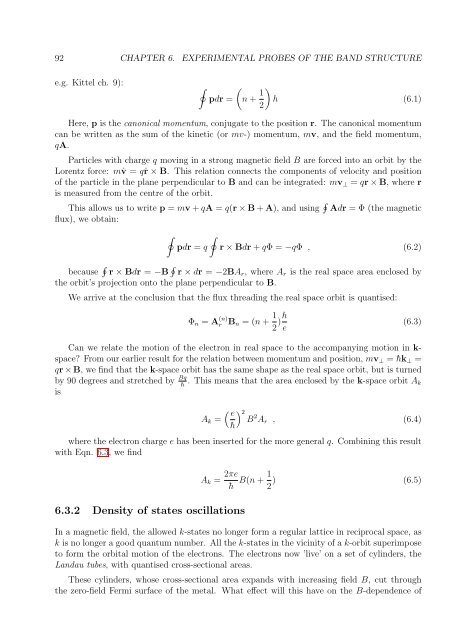Set of supplementary notes.
Set of supplementary notes.
Set of supplementary notes.
You also want an ePaper? Increase the reach of your titles
YUMPU automatically turns print PDFs into web optimized ePapers that Google loves.
92 CHAPTER 6. EXPERIMENTAL PROBES OF THE BAND STRUCTURE<br />
e.g. Kittel ch. 9):<br />
∮<br />
pdr =<br />
(<br />
n + 1 )<br />
h (6.1)<br />
2<br />
Here, p is the canonical momentum, conjugate to the position r. The canonical momentum<br />
can be written as the sum <strong>of</strong> the kinetic (or mv-) momentum, mv, and the field momentum,<br />
qA.<br />
Particles with charge q moving in a strong magnetic field B are forced into an orbit by the<br />
Lorentz force: m ˙v = qṙ × B. This relation connects the components <strong>of</strong> velocity and position<br />
<strong>of</strong> the particle in the plane perpendicular to B and can be integrated: mv ⊥ = qr × B, where r<br />
is measured from the centre <strong>of</strong> the orbit.<br />
This allows us to write p = mv + qA = q(r × B + A), and using ∮ Adr = Φ (the magnetic<br />
flux), we obtain:<br />
∮<br />
∮<br />
pdr = q<br />
r × Bdr + qΦ = −qΦ , (6.2)<br />
because ∮ r × Bdr = −B ∮ r × dr = −2BA r , where A r is the real space area enclosed by<br />
the orbit’s projection onto the plane perpendicular to B.<br />
We arrive at the conclusion that the flux threading the real space orbit is quantised:<br />
Φ n = A (n)<br />
r B n = (n + 1 2 )h e<br />
(6.3)<br />
Can we relate the motion <strong>of</strong> the electron in real space to the accompanying motion in k-<br />
space From our earlier result for the relation between momentum and position, mv ⊥ = h¯k ⊥ =<br />
qr × B, we find that the k-space orbit has the same shape as the real space orbit, but is turned<br />
by 90 degrees and stretched by Bq . This means that the area enclosed by the k-space orbit A h¯ k<br />
is<br />
( e<br />
) 2<br />
A k = B 2 A r , (6.4)<br />
h¯<br />
where the electron charge e has been inserted for the more general q. Combining this result<br />
with Eqn. 6.3, we find<br />
6.3.2 Density <strong>of</strong> states oscillations<br />
A k = 2πe<br />
h¯ B(n + 1 2 ) (6.5)<br />
In a magnetic field, the allowed k-states no longer form a regular lattice in reciprocal space, as<br />
k is no longer a good quantum number. All the k-states in the vicinity <strong>of</strong> a k-orbit superimpose<br />
to form the orbital motion <strong>of</strong> the electrons. The electrons now ’live’ on a set <strong>of</strong> cylinders, the<br />
Landau tubes, with quantised cross-sectional areas.<br />
These cylinders, whose cross-sectional area expands with increasing field B, cut through<br />
the zero-field Fermi surface <strong>of</strong> the metal. What effect will this have on the B-dependence <strong>of</strong>








